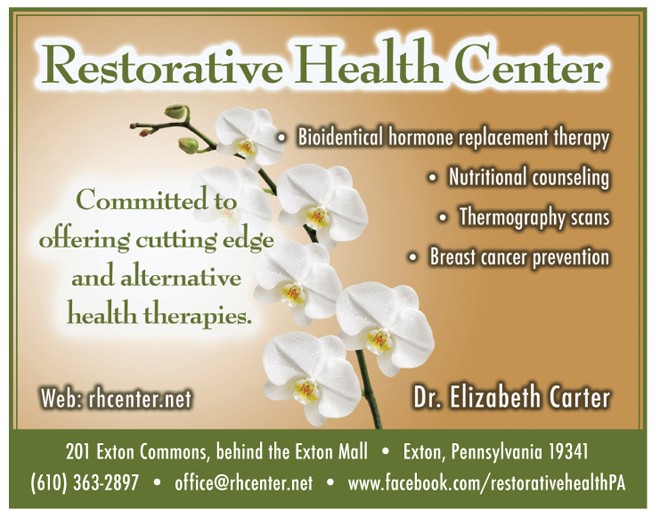What is Natural Bio-Identical Hormone Replacement Therapy?
 By Dr. Elizabeth Carter
By Dr. Elizabeth Carter
Many women, as well as most doctors, are confused as to what Natural Bio-Identical Hormone Replacement Therapy (BHRT) is and whether it is good for you or not? How is it different from traditional Hormone Replacement Therapy (HRT)?
The confusion arises because no distinction is made between traditional synthetic HRT and natural BHRT in studies and articles written about traditional hormone replacement therapy. Studies merely talk about hormone replacement therapy, and continually meld HRT and BHRT.
To compare synthetic products and natural products is like comparing apples and oranges. It is no wonder that everyone, doctors included, are often confused. When you look at studies using natural BHRT, you will find it to be safe and helpful in maintaining your body’s normal functions.
What Are Synthetic Hormones?
Traditional HRT refers to giving hormones made from conjugated equine estrogens (CEE) from the urine of pregnant mares called Premarin and/or Premarin combined with progestin medroxyprogesterone acetate called Prempro. Synthetic estrogen is referred to as CEEs. Synthetic progesterone is referred to as progestins. All synthetic drugs contain fillers and coatings that may or may not cause side effects.
The synthetic estrogen Premarin contains many different kinds of estrogens that are not capable of fitting into human estrogen receptors sites. There are no studies to date that show what happens to these circulating estrogens, as they cannot be detected when testing for estrogens in saliva, urine or blood. Although earlier studies show Premarin may increase dementia, in the French E3N study 2004, it was also found it may be anti-cancerous for breast cancer. (French E3N Study 2004-Int.J.Cancer 114, 484-454 (2005); www.ncbi.nih.gov/pmc/articles/PCM2211383).
What Are Natural
Bio-Identical Hormones?
Natural BHRT has only been offered in the United States as an alternative to synthetic hormone replacement in the last few decades. However, it was first used in this country by the American Indians for menopausal symptoms in the form of wild yams. Wild yams, soybeans and peanut oil are used today to make natural estrogen and progesterone compounds. The bio-identical hormones known as 17 beta-estradiol and progesterone have been FDA approved. Peanut oil is used to make an FDA-approved progesterone called Prometrium.
The word “Natural” when referring to hormones means “the exact same chemical structure as what your body makes.” This does not mean all bio-identical hormones are made from plants. Hormones produced in a laboratory, having the same chemical structure as your body’s are natural and bio-identical. Everything else is synthetic.
HRT Vs. BHRT
What Estrogen To Use And Why
Before the Women’s Health Initiative Study Results became known, HRT was known for the treatment of menopause symptoms with synthetic hormones. Now HRT is often used to describe BHRT. Traditional HRT and BHRT are totally different ways to treating lack of hormones, the similarities and differences of which has created much confusion.
To add to the confusion, the FDA has authorized that the same precautions for HRT be put on drug side effect inserts of BHRT. To be clear, HRT and BHRT are not the same drug; they do not have the same side effects.
Bio-identical hormones are often made from wild yam. The hormones found in wild yam are biologically identical to the chemical structure your body makes. Your body makes three different kinds of estrogens called Estrone or E1, Estradiol or E2, and Estriol or E3. Synthetic estrogen comes in many forms. The most common synthetic estrogen prescribed is a pill called Premarin. It comes from horse urine and is a mixture of E1, sodium equilin sulfate, 17 alpha-dihydroequilin, 17 alpha-estraddiok, and 17 betadihydroequilin.
The horse estrogens are equilin and equilenin. Additives and the coating of the pill are added which may cause a burning sensation when urinating, allergic reactions, and joint aches and pains. The estrogens found in Premarin and other synthetic estrogens contain many forms of estrogen that do not fit into the estrogen receptor sites in the human body.
What happens because of this is not completely known, however, it is known that the synthetic estrogens stay in your body for 13 weeks because we do not have the capability of breaking down equine estrogens. Estradiol your body makes, is eliminated from your body via the urine in one day.
Bio-identical hormones are broken down and are bioavailable for use in our body. It is most commonly given in a cream form. It can be given as E2 alone, or it can be given as a combination of E2 and E3 in different percentages.
“Phased Hormonal Cycles”
From the book by T.S. Wiley Sex, Lies and Menopause, What Your Doctor Is Not Telling You. The light of the moon is why we, as women, cycle between 28 and 30 days. We are no longer able to distinguish those phases of natural light, due to our overexposure to synthetic, cheap electricity. Overexposure of even a light bulb in your refrigerator can inhibit your melatonin release, which will disrupt your natural rhythm of estrogen. If that happens, then the natural balance we
are striving for is disrupted, destabilizing the very thing we are striving for –
the estrogen fitting in the receptor site.
“It may be bio-identical, but it won’t help you if you don’t do it right. A knowledgeable doctor who can educate you makes all the difference. Be involved in your health.You have to live what you learn to stay healthy.” ~ Sherry N., Berwyn, PA
Dr. Elizabeth Carter is a Chiropractor, Naturopath, and medical student, who has served the Main Line and Philadelphia area for 18 years, specializing in pediatric, pregnancy, and nutrition. Her practice, Restorative Health Center, is based in Exton, PA.
With a background in gymnastics, professional dance and her passion for outdoor adventure, Dr. Carter is well versed in movement, natural body connections, and holistic healing. Along with Chiropractic services, Dr. Carter utilizes naturopathic healing strategies in an effort to promote true body and mental health.
Her education spans from a Bachelor of Fine Arts degree in Dance, from Temple University, to Doctor of Chiropractic from Pennsylvania College of Chiropractic, along with her many certifications in Pediatrics and Pregnancy Chiropractic, Physiologic Therapeutics, Cranial Sacral Therapy, Trigger Point Therapy. Dr. Carter is a Certified Thermography Technician and oversees a certified Thermography center. Dr. Carter is an Affiliate with the BX Protocol and is currently enrolled in medical school, along with working towards her fellowship with the Wilderness Medical Society. Dr. Carter
is certified in The Wiley Protocol® bio-identical hormone replacement therapy for anti-aging. Dr. Carter is also on
the Program Advisory Committee for the Professional Massage Therapy Program at the Berks Technical Institute.
Restorative Health Center is located at 201 Exton Commons, behind the Exton Mall. For hours, questions and to schedule an appointment, call(610) 363-2897, or email us at [email protected].


